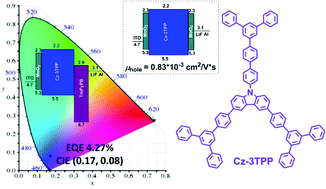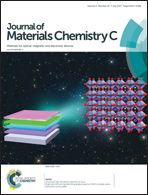New insight into intramolecular conjugation in the design of efficient blue materials: from the control of emission to absorption†
Abstract
Three blue luminogens, Cz-3tPE, TPA-3TPP and Cz-3TPP, have been successfully synthesized, in which intramolecular conjugation has been restricted effectively by decreasing the unsaturated bonds and weakening the electron donating ability of the molecular building blocks, which is much different from previous strategies. Due to the introduction of triphenylamine and carbazole groups, these luminogens exhibited excellent hole-transporting abilities, with a maximum hole mobility of up to 10−3 cm2 V−1 s−1, which was better than most commercial hole-transporting materials. Once fabricated as emitters in OLEDs, as a result of the controlled conjugation, their EL emissions were blue-shifted from pure blue (464 nm) to deep blue (436 nm), and then to blue-violet (397 nm). Excitingly, Cz-3TPP exhibited the best EL performance, with a maximum external quantum efficiency of up to 4.27% at 397 nm without a hole-transporting layer, which is among the highest reported performances for double-layer OLEDs with deep blue emission.



 Please wait while we load your content...
Please wait while we load your content...